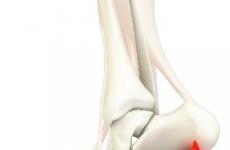What heels can be worn during pregnancy in the early and late stages, is it possible to go to work in heels, and what are the requirements for shoes. Why shouldn't pregnant women wear high heels? Allowable heel height during pregnancy Wearing heels during pregnancy
I remember myself before the first pregnancy - all the shoes with stilettos - I ran on them from morning to evening, and did not know grief. However, the tummy began to grow, the legs began to swell, and, if necessary, I had to buy ballet flats. However, there are also stubborn girls who almost go to the hospital in heels. Why is this dangerous, and in general, is it possible for pregnant women to walk in heels? We'll find out soon!
It's hard to miss a woman in heels. She becomes slimmer and more attractive overnight. This is noticed by everyone around, and especially by members of the opposite sex. In order to stand out in their eyes, many women neglect the rules that state that pregnancy and high heel shoes are incompatible concepts.
Do you know why they are incompatible? It turns out it's all about the heel mechanics. Nature has cleverly designed the muscles and tendons of the legs that act as springs. As you walk, they stretch, take on the load, and provide additional energy for the next step. We do not even suspect about their work, because everything happens synchronously.
Such a harmonious process is disturbed by elevation, and this is precisely what the heel represents. It literally blocks natural "springs", depriving the foot of its natural capabilities. As a result, the load on the legs increases significantly, but this is not the most important thing. Shoes with heels change the position of the body.
The very beautiful posture that others are staring at is the result of a change in the fulcrum. Now the young lady is leaning on her toe when walking. It is easy to guess that this affects stability, simultaneously weakening the ligaments of the ankle joint and foot. Additionally, the center of gravity is shifted forward. To maintain balance, a woman has to lean back slightly.
The position is seductive, because then a bend in the lower back is drawn, but there is little pleasant in it: with regular wearing of shoes with heels, the curvature of the spine and displacement of internal organs are provoked. Along the way, the muscles of the pelvis, legs, lumbar spine are constantly tense, which in combination leads to the most unpleasant consequences in the form of heaviness in the limbs, circulatory disorders, varicose veins and even flat feet.
Danger during pregnancy
To understand why it is impossible to wear heels during pregnancy, it is enough to analyze the changes that occur in the body in an interesting position. First of all, the hormonal background changes.
In general, there is nothing wrong with this, if you do not take into account what it also affects the ligaments: they relax, become looser. Add to this the increased load on muscles and blood vessels, and you will understand that varicose veins and flat feet are not an opportunity, but a reality, at least for many expectant mothers.
This is not the end of the troubles that shoes with heels can entail in the early or late stages of pregnancy. Possible:
- Injuries. Look at the statistics of falls and dislocations concerning the representatives of the beautiful half of humanity, who cannot imagine their life without elegant boats or hairpins. For those who are in an interesting position, it increases significantly. Do you know why? The spinal ligaments are now weakened, and any sudden movements threaten the displacement of the vertebrae. Hence, by the way, and lower back pain, and leg cramps.
- Risk of miscarriage. Who among us did not suffer from uterine tone during pregnancy? Perhaps only a few. The rest are at risk, since in such conditions the situation is aggravated by a strong overstrain of the leg muscles, which adds stress on the spine and hip joints. The latter, just, and can increase the tone.
- Saggy belly, stretch marks. Do you want to stay beautiful after giving birth? Heed the advice of doctors who say that heels should be abandoned early in pregnancy. Injuries have nothing to do with it. When the center of gravity shifts, the stomach bulges out, and since the skin is already stretched, it also sags over time. Everything can end with the so-called leather apron.
- Malposition. When the center of gravity shifts, the baby runs the risk of lying down incorrectly. As a result, the doctor can fix the transverse or breech presentation and send the future woman in labor for a cesarean section. But he might not have been, had she given up the wrong shoes in time.
- Convulsions. They are the result of overstrain of the gastrocnemius muscle and are especially annoying for women for long periods of time.
- Loss of balance. Nature intended that in the second trimester, the woman's center of gravity should shift. If she “puts her hand on it,” that is, wears shoes with heels, one fine day everything can end in a fall due to the inability to maintain balance.
- Puffiness. In the third trimester, many women develop edema. Of course, both their current situation and their diet are to blame, but narrow shoes with heels or a platform add fuel to the fire, which impedes the outflow of fluid.
Also, muscle sprains, back and leg pain in the evening are possible, and all due to heels.
How long can you wear high heels?
Ideally, heels are contraindicated in both the first and third trimester. Meanwhile, life, or rather, the order in the office sometimes dictates its own rules to us women. A strict dress code provides for the wearing of high-heeled shoes, and the doctor prohibits it during pregnancy. What to do in this situation? Find a compromise. 
In the early stages, the heel is acceptable if there are no contraindications - the tone of the muscles of the uterus, the threat of miscarriage, varicose veins. Moreover, you can even wear a hairpin, although a stable small one is still more preferable. In the later, it is better to choose something on a low speed.
What heels can be worn during pregnancy at different times
It is easiest for women in the first trimester. There, the tummy is still small, so the load on the joints has not yet increased. Most of the beautiful women continue to wear shoes with their favorite heels and do not even rush to change shoes. You can understand them, especially since it is important for them to enjoy such walking, because very soon everything will change.
In the second trimester, we need to keep an eye on what we wear. No matter how convenient, a hairpin during this period is not the best option. Even if it is as stable as possible or small enough. She loses to all other types of heels due to the risk of injury and a negative effect on the anatomy of the foot. As a result, a woman has to balance all the time in order to maintain balance, and no one knows how this may end sooner or later.
Some women prefer wedges. Thin and seemingly reminiscent of a heel, it is, in fact, heel, though in combination with the platform. Whatever one may say, but this is also not the best option, although it has clear advantages: in such shoes, a smoother transition from the front to the back is provided, due to which the negative impact on the foot becomes less pronounced.
The third trimester is the most difficult, because the tummy at this time is significantly enlarged. What heels can you wear at this time? On small ones, 3 - 5 cm high. Another acceptable option is a stable wedge heel. It is also not recommended to be completely without a heel, otherwise it will lead to expansion, flattening of the foot and the development of flat feet.
Is it possible for pregnant women to walk in heels
Summing up all of the above, we can answer that both in the early stages and in the later, a pregnant woman can pamper herself with high-heeled shoes. The main thing is to closely monitor your health and refuse it when the first signs of malaise or contraindications appear.
In addition, it is very important to comply with safety rules in such situations, namely:

To minimize stress on the foot, walk and stand on heels as little as possible, for example, changing into more comfortable shoes, sitting at a table or during lunch. Another option is to purchase an instep support to support the arch of the foot.
Lovers of models with a narrow toe should pay attention to the spacers for the thumb or gel pads: they prevent deformation.
Well, and most importantly, after a hard day at work, do not forget to pamper your legs with a warm bath (water 37 - 39 degrees) and a light massage. They will be very grateful to you for this!
Shoes with heels have become so firmly established in the life of a modern woman that even pregnancy does not become a reason to abandon it. Despite the prohibitions of doctors, many expectant mothers continue to wear graceful shoes with thin heels and their favorite platform boots almost until the very birth. Gynecologists warn: the heel is dangerous! Wearing such shoes creates a serious load on the spine, pelvic and leg muscles, which means it interferes with the work of internal organs. Is it worth risking your health if you can give up on heels for a while, preferring comfortable, stable shoes?
The danger of high heels
Wearing shoes with heels creates certain problems:
- The center of gravity shifts and the fulcrum changes. Normally, body weight should be on the entire foot. When wearing high-heeled shoes, this does not happen, and the weight falls only on the metatarsal bones. This position does not contribute to good stability and increases the likelihood of a fall. Injuries during pregnancy can have serious consequences, including miscarriage.
- Wearing shoes with heels increases the stress on the ligaments of the foot and ankle, which leads to pain and swelling.
- The heel increases the stress on the spine. Wearing uncomfortable shoes increases lumbar lordosis (natural bending). The center of gravity shifts forward, chronic pain in the lumbar region occurs.
- Walking in heels increases the load on the pelvic muscles, which also does not contribute to improving well-being.
- Excessive stress on the muscles of the legs worsens the condition of the veins of the lower extremities and creates conditions for the development of varicose veins. Varicose veins are a direct path to thrombosis.
In anticipation of the baby, the woman's body changes significantly. The increasing load on the legs leads to the appearance of a "duck gait", which becomes especially noticeable in the later stages. The woman walks slowly and waddled, but this is not at all the main problem. Under the influence of progesterone, the ligaments soften and stretch, the load on the muscles and blood vessels increases - and all this happens even when wearing ordinary comfortable shoes.
What will happen if the expectant mother puts on high-heeled shoes, contrary to the prohibitions of doctors? The load on the ligaments, muscles and joints will increase, which will lead to unpleasant symptoms:
- heaviness and pain in the legs, especially after long walking and in the evening;
- swelling of the lower extremities;
- the appearance of varicose veins or worsening of the condition with existing disorders;
- pain in the lumbar region;
- cramps of the calf muscles.
The appearance of stretch marks on the abdomen is also associated with wearing uncomfortable shoes. Excessive bending forward when using heels leads to excessive stretching of the abdominal muscles. Divergence of muscles provokes skin tension, which causes stretch marks.
Wearing shoes with heels significantly increases the risk of joint dislocation during careless movements, and also leads to displacement of the vertebrae.
If you really want to, can you?
Gynecologists are categorical in this matter: a pregnant woman should not wear high-heeled shoes - from 4-5 cm. Studs are strictly prohibited as the most unstable option that creates maximum stress on muscles and ligaments. It is not recommended to wear shoes on a high platform, including "grinders" fashionable in some environment. It is better to put such shoes in the closet - they will still come in handy for a young mother after the birth of a child.
It would seem that the most convenient option for a pregnant woman is ballet flats, pumps and sneakers. But here orthopedic doctors are already protesting, categorically not recommending such shoes to any of their patients, and to expectant mothers in particular. A flat sole does not support the foot, which means it creates an increased load on the spine, pelvic ligaments, joints and vessels of the lower extremities. From the point of view of possible injury, ballet flats and sneakers are safer, but you should not get carried away with such shoes either.
The best option for a pregnant woman is shoes with a dense, but not hard back, with a small stable heel - up to 3 cm. You can wear shoes without a pronounced heel, but on a comfortable wedge heel. It can be shoes, boots, boots - everything that seems comfortable and will be appropriate for the season. When choosing sandals and sneakers, you should also give preference to comfortable models with a formed arch.
Important aspects:
- Pregnant women with flat feet should wear special orthopedic insoles.
- With varicose veins, do not forget about elastic knitwear. You need to wear compression underwear daily until the very birth.
- The sole of the chosen shoe should be grooved - this will additionally protect the pregnant woman from falling. If the sole of the chosen shoe is slipping, you can correct the situation in the shoe shop.
- Shoes must be of the right size. Shoes that are too tight or, on the contrary, loose are no better than dangerous stilettos and high heels.
In the first trimester, while the load on the woman's body is not so significant, you can please yourself with your favorite shoes or high-heeled boots. But even in this case, you should forget about stilettos, preferring more stable options. Shoes with heels can be worn for a holiday or a business meeting, but no more than 2-3 hours. After 12-16 weeks, you need to finally switch to comfortable and safe shoes.
High heels are an amazing thing: put on - a gorgeous woman, took off - a happy person ...
Many have heard this anecdotal statement and many will agree with it. Shoes with high heels not only lead to severe fatigue of the legs, back and the entire musculoskeletal system, but also, if worn regularly, can cause many health problems. This applies to any woman, and especially to a pregnant woman. Indeed, during the period of bearing a child, all the risks associated with wearing heels increase several times!
Why shouldn't you wear high heels during pregnancy?
In spite of everything, there are always women who wear high-heeled shoes at least several times during pregnancy, without even thinking that this may be harmful or unacceptable. But if you ask any adequate doctor about this, the answer will be unequivocal: no. None of the doctors will recommend that a pregnant woman wear such uncomfortable and unsafe shoes while carrying a child.
And all because wearing high heels during pregnancy is directly related to a number of threats and risks for the expectant mother and her baby:
- First of all, the woman's legs are affected. And without heels, they now get more tired and hurt more often than before pregnancy. Under the influence of hormones, the ligaments soften, and the muscle tone decreases. When walking in heels, the ankle and foot are under great stress, and they increase under the weight of the pregnant woman with an increase in the term. Podiatrists say that this increases the risk of flat feet and calf muscle cramps. Also, high heels are a risk factor for the development or exacerbation of varicose veins. And if you have suffered from this ailment in the past, then it is better to refuse high heels altogether, and during pregnancy - in strict order!
- The spinal column, lower back and pelvic area also suffer: a woman has to unnaturally and unusually bend her back, due to which the bones and muscles in these zones receive high loads and are highly overstrained.
- "Looseness" of the ligaments increases the risk of injury and dislocation, which are already high when a woman is in heels.
- For the same reason, as well as due to a strong shift in the load of the whole body in advance and a decrease in the stability of the body of a pregnant woman, there is a very high probability of falling, which can be dangerous at any stage of pregnancy. The larger the tummy, the more the center of gravity of the whole body shifts forward. If you put on high-heeled shoes during pregnancy, this effect will be even stronger.
- Long-term or regular wearing of high-heeled shoes can cause an increase in uterine tone, which is known to entail the risk of miscarriage and termination of pregnancy.
- The higher the heel, the more the woman's weight pulls her forward, the more she tries to resist this, arching the backward ridge, the more the skin in the abdomen and sides is pulled and stretched. And even if this is not the greatest danger for pregnancy, after giving birth it becomes almost impossible to get rid of the resulting stretch marks and sagging skin on the abdomen.
- Even in the most comfortable and physiological shoes, pregnant women often experience edema during prolonged walking and staying on their feet. Heels multiply these risks and the degree of their manifestation.
- Wearing uncomfortable and high-heeled shoes, among other things, significantly impairs blood circulation in the lower extremities and the pelvic region, where blood is supplied by the veins in the legs. This means that the fetus may not receive vital oxygen and nutrients that come to it along with the blood.
- Frequent wearing of high-heeled shoes in the second and third trimesters of pregnancy can cause displacement of internal organs (due to the fact that a woman bends the spine in a special way during such walking), and in particular the uterus. Such changes can become a serious obstacle for the child, preventing him from taking the correct, most physiological position in the uterus before childbirth - vertical, or head down.
It would seem that just heels are a rather familiar attribute in the everyday life of many ladies, and it can carry so many problems in itself, the list of which increases with the onset of pregnancy. There is something to think about here. However, most pregnant women refuse high heels in favor of their own and their child's health without any hesitation.
Early pregnancy heels
But it often happens that a woman runs in heels all day long, practically without taking off, and suddenly finds out that she is pregnant! She naturally asks the question: is it possible to wear heels in the early stages of pregnancy and is it capable of somehow harming the baby or the very process of carrying it?
If by the time you found out about the pregnancy, it was not interrupted, then everything is fine! This will not have any serious consequences. But now the high heels will still have to be removed for the benefit of themselves and the future baby.
It is permissible in the early stages to put on shoes "at high speed" once and for a short time, provided that they are comfortable and you do not have to walk a lot or stand for a long time, and at the same time, you need to take care of the possibility at any time to change into a more comfortable "low" shoes. But remember that the risk of termination of pregnancy is highest in the first trimester, and therefore if you can do without heels, then it is better to do this.
Can heels be worn during pregnancy?
And yet, "no" is very often a relative adverb in its meaning and categoricality. Well, once or twice and for a little while, is it possible? Let's try to put the question differently: is it necessary to wear heels during pregnancy? We must admit that stiletto heels are not suitable for every woman and not in every situation. The heel should match the outfit, the event, the woman's ability to hold on and walk in such shoes, in general, be appropriate in every sense.
One can argue about the appropriateness of high heels during pregnancy. Even if you are going to a celebration or wearing such shoes is part of the dress code for work, you can always find a more suitable alternative for a pregnant woman. Moreover, the outfits of expectant mothers are also gradually being replaced by more comfortable and practical (albeit no less beautiful) styles than before. A woman with a tummy, pumping from side to side while walking (this is due to a change in the bend of the ridge, which we talked about above), and even on high heels - a sight, at least comical (according to many observers from the side) ...
Nevertheless, it is imperative to wear heels during pregnancy, according to orthopedists! But these should be wide, stable, comfortable heels with a height of 3 to 5 cm. Shoes with a solid sole, like high heels, are not physiologically correct (this applies to all women, not only those carrying a pregnancy).
The correct shoes for pregnant women should be comfortable, soft, not causing any discomfort when wearing, not squeezing, but fixing the leg well. In addition to a low, wide, stable heel, an important requirement for it is production from natural fabrics and materials. It is good if your shoes or boots are breathable so that your feet do not sweat.
And one more piece of advice to expectant mothers who choose the right shoes for themselves: try on new clothes when buying in the afternoon. At this time, the leg slightly swells and swells, and this condition, most likely, will accompany you until the end of bearing the child. And therefore, in order not to suffer later and not to experience severe constraint on the legs, it is better to measure shoes taking this circumstance into account.
Especially for - Margarita SOLOVIEVA
Why shouldn't pregnant women walk in heels? Future mothers ask themselves, being in the first weeks of an interesting situation. Or maybe you can? And nothing terrible will happen? Let's take a look at the common opinions and misconceptions on this score.
According to psychologists, the syndrome of desire for heels during pregnancy is caused by one reason. A woman, even looking forward to this joyful event, suddenly realizes that her life will change dramatically. There will no longer be much that was characteristic of her in everyday life, the way and priorities will change. In the end, the appearance will change, and it is not yet known in which direction. She wants to remain beautiful and attractive in the eyes of others for as long as possible. And it seems that heels are what you need for this.
But doctors, when asked what will happen if you wear heels during pregnancy, say warningly: nothing good. And this is due to the structural features of the foot and changes in the female body.
Why does the foot suffer
The structure of the foot includes about 30 bones. In a standing position, the load from the body weight is distributed on them more or less evenly, although the main pressure falls on the back section (heel) and middle (arch of the foot). Joints are also present here. Despite their small size, there are 33 of them in each foot. The purpose of these joints is to cushion when walking so that the knee and hip joints experience less stress.
What happens when a woman puts on a high stiletto heel? Understanding this will allow you to yourself answer the question of whether pregnant women can walk in heels.
- The centers of gravity are shifted. Instead of evenly distributing them on three points of the feet, the entire weight of the body should be borne by the phalanges of the toes and the forefoot, for which this load is unusual.
- The center of gravity shifts forward. The spine adapts to new conditions. He bends unusually in the lower back.
- Compensatory response to lumbar bending occurs: the spine also arches in the thoracic region.
- Violation of the natural position of the spine leads to changes in the position of internal organs and blood circulation.
There are negative changes in the legs themselves. The redistribution of the load literally knocks the lower legs out of the general work of the muscles. Over time, they become flabby and weak. This leads to impaired blood flow, stagnation, contributing to the development of varicose veins.
Are heels and pregnancy compatible?
And what about during pregnancy? The situation is getting worse.

In addition to physiological problems, the banal aspect of safety should also be taken into account. It is impossible to walk in heels on ice and rain without endangering the health of the baby. Yes, in normal weather, a thin stiletto heel that makes the leg balance, creates the risk of twisting the ankle or falling dangerously.
What shoes should a mother-to-be choose
Despite the danger of wearing heels, doctors do not urge to give them up completely. And when asked whether it is possible for pregnant women to wear heels, they answer: it is possible, but special.
 Instead of a high stiletto heel, choose:
Instead of a high stiletto heel, choose:
- heel 3-5 cm high- it will ensure the correct position of the foot, will become a competent prevention of flat feet.
- wedge - it supports the foot in a natural position, and from the back it looks exactly like a heel.
Do not advise doctors and go to extremes, preferring running shoes instead of your favorite shoes. The former, like ballet flats, pumps and other low-speed shoes, stimulate flattening of the foot, causing the development of flat feet. If it is these shoes that are convenient for you, during pregnancy, supplement it with an orthopedic insole with an instep support.
And don't forget about heels during early pregnancy. As long as the weight of the tummy is not heavy, wear them with pleasure. When doing this, always carry a more comfortable change of shoes in case your feet get tired. In the evening, pamper your feet with a warm bath (temperature up to 38 ° C) and a light massage.








